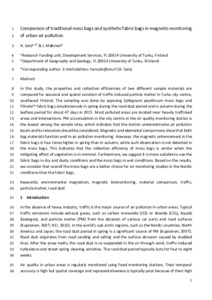Comparison of traditional moss bags and synthetic fabric bags in magnetic monitoring of urban air pollution
Salo Hanna; Mäkinen Joni
https://urn.fi/URN:NBN:fi-fe2021042824376
Tiivistelmä
In this study, the properties and collection efficiencies of two different sample materials are compared for seasonal and spatial variation of traffic-induced particle matter in Turku city centre, southwest Finland. The sampling was done by exposing Sphagnum papillosum moss bags and Filtrete™ fabric bags simultaneously in spring during the road dust period and in autumn during the leafless period for about 47 days in 2015. Most polluted areas are located near heavily trafficked areas and intersections. PM accumulation in the city centre at the air quality monitoring station is the lowest among the sample sites, which indicates that the station underestimates air pollution levels and its relocation should be considered. Magnetic and elemental comparisons show that both bag materials function well in air pollution monitoring. However, the magnetic enhancement in the fabric bags is four times higher in spring than in autumn, while such observation is not detected in the moss bags. This indicates that the collection efficiency of moss bags is similar when the mitigating effect of vegetation is in minimal. Furthermore, we suggest it is more suitable to use the fabric bags in dry and dusty conditions and the moss bags in wet conditions. Based on the results, we consider that overall the moss bags are a better choice for air monitoring studies in the Nordic conditions than the fabric bags.
Kokoelmat
- Rinnakkaistallenteet [27094]
